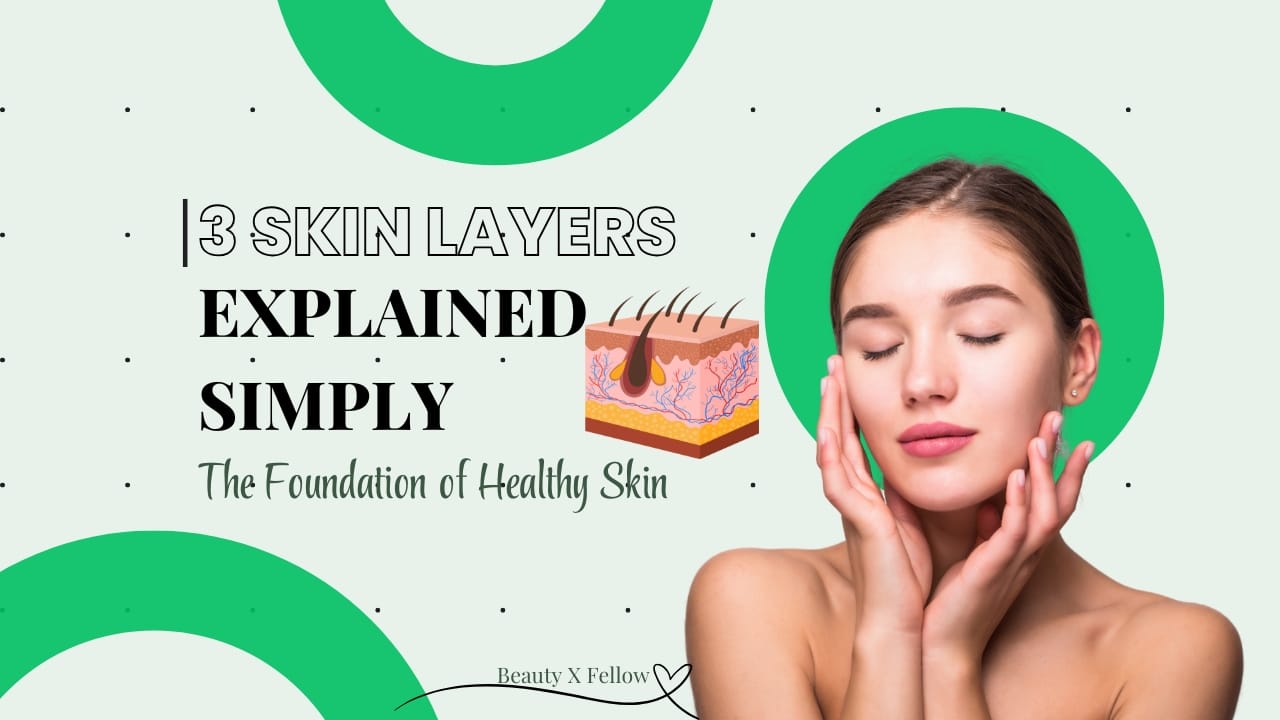
Healthy, glowing skin is one of the most universally desired features. It’s not just about aesthetics—your skin plays a vital role in your overall health and confidence. Yet, many people dive straight into buying the “best” products, hoping for a magic formula, but without understanding how the skin works, it’s like trying to build a house without a foundation. Skin health isn’t just about what you put on your face—it’s about understanding your skin from the inside out.
The truth is, achieving healthy skin starts with knowledge. By understanding the structure of your skin and how its layers function together, you can make smarter skincare choices and address your unique concerns effectively. In this article, we’ll break down the layers of the skin, explain their roles, and provide expert tips to maintain healthy skin at every level.
What Is Skin and Why Does It Matter?
Your skin is your body’s largest organ, covering approximately 2 square metres and weighing about 8 pounds. It’s more than just a protective covering—it’s a complex system that:
- Shields you from harmful elements like bacteria, UV rays, and pollution.
- Regulates body temperature and prevents water loss.
- Reflects your internal health and well-being.
But here’s the catch: your skin is only as healthy as the care you give it. To truly care for your skin, you need to understand its structure and how each layer contributes to its overall function.
Skin Layers Explained Simply: the Three Layers Breakdown
Your skin is made up of three main layers, each with distinct roles:
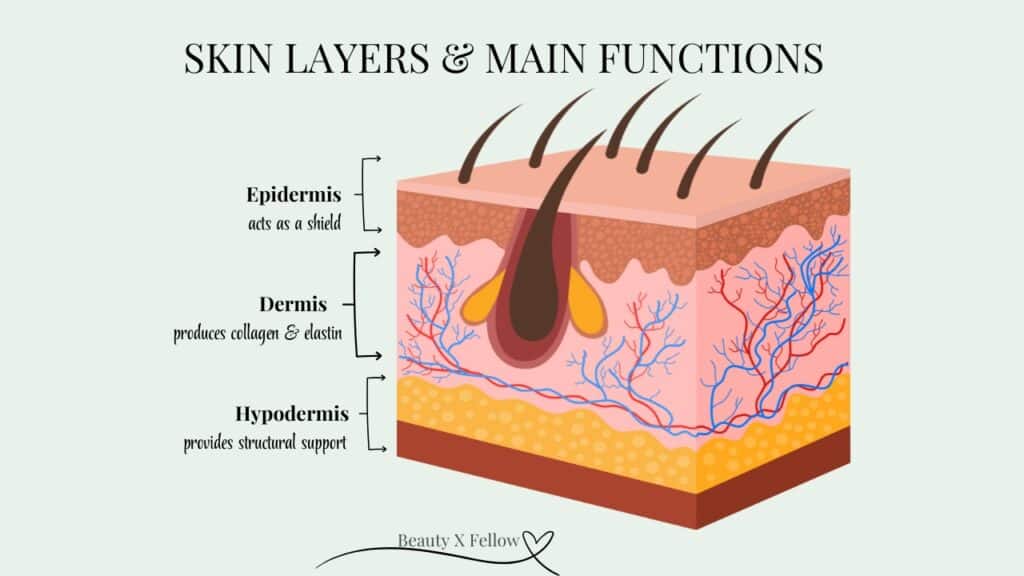
1. Epidermis: The Outer Shield
The epidermis is the outermost layer of your skin and the first line of defence against the environment.
- Key Features:
- Made up of keratinocytes (skin cells) that renew every 28-40 days.
- Contains melanocytes, which produce melanin (responsible for your skin tone).
- Includes the stratum corneum, the topmost layer, which is made of dead skin cells and natural oils to lock in moisture.
- Functions:
- Acts as a waterproof barrier.
- Protects against harmful UV rays, bacteria, and pollutants.
- Prevents water loss to keep your skin hydrated.
- Common Skin Issues:
- Dryness and flakiness: Caused by a damaged stratum corneum.
- Hyperpigmentation: Results from overactive melanocytes.
- Acne: Often starts here when pores become clogged.
- How to Care for the Epidermis:
- Use a gentle cleanser to avoid stripping natural oils.
- Apply a broad-spectrum sunscreen daily to protect against UV damage.
- Incorporate moisturisers with ceramides to strengthen the skin barrier.
- Exfoliate 1-2 times a week to remove dead skin cells, but avoid over-exfoliation.
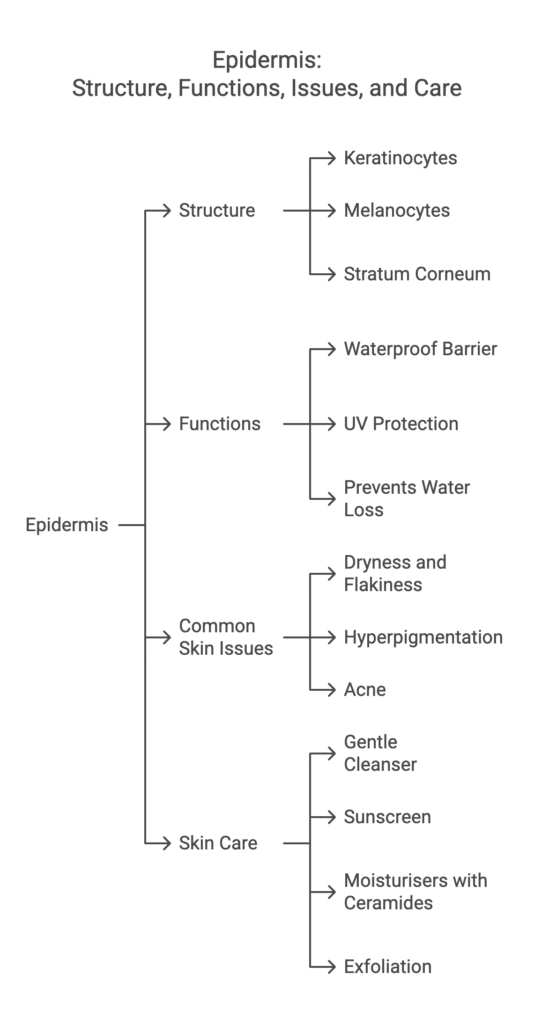
2. Dermis: The Support System
The dermis lies beneath the epidermis and is the thickest layer of your skin. It’s where most of the skin’s “work” happens.
- Key Features:
- Contains collagen and elastin, which give your skin its firmness and elasticity.
- Houses blood vessels, sweat glands, sebaceous (oil) glands, and hair follicles.
- Includes nerve endings that allow you to feel sensations like touch and temperature.
- Functions:
- Provides structural support to the epidermis.
- Regulates hydration through sweat and oil production.
- Supplies nutrients and oxygen to the skin.
- Common Skin Issues:
- Wrinkles and sagging: Caused by the breakdown of collagen and elastin.
- Acne: Can occur when sebaceous glands overproduce oil.
- Redness and sensitivity: Linked to inflammation in the dermis.
- How to Care for the Dermis:
- Use retinoids or peptides to stimulate collagen production.
- Apply hydrating serums with hyaluronic acid to plump the skin.
- Incorporate antioxidants (like vitamin C) to protect against free radical damage.
- Stay hydrated and eat a diet rich in skin-friendly nutrients like omega-3s and vitamin E.
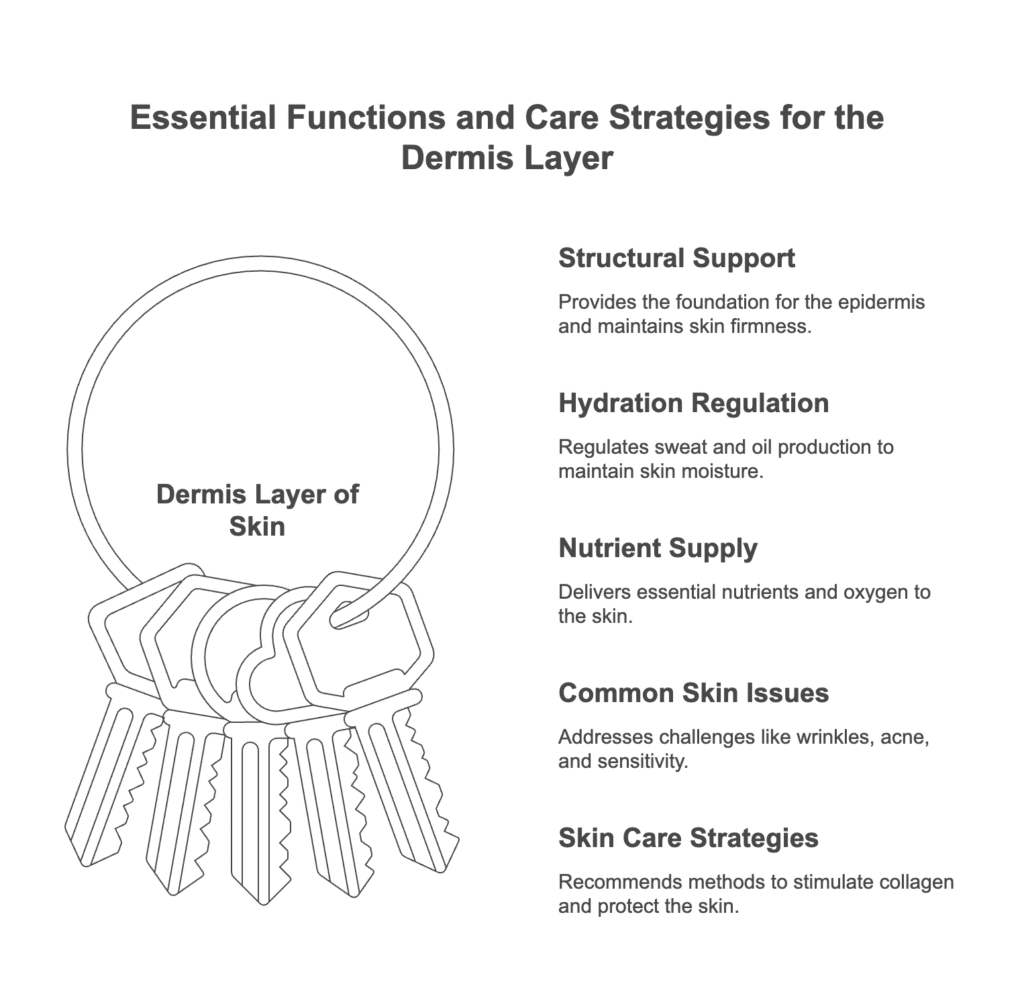
3. Hypodermis: The Deep Cushion
The hypodermis, or subcutaneous layer, is the innermost layer of skin. It’s made up of fat and connective tissue.
- Key Features:
- Stores energy in the form of fat.
- Provides insulation to regulate body temperature.
- Acts as a cushion to protect muscles and bones.
- Functions:
- Supports the upper layers of skin.
- Helps maintain the skin’s plumpness and volume.
- Common Skin Issues:
- Loss of volume and sagging: Occurs as fat stores decrease with age.
- How to Care for the Hypodermis:
- While skincare products don’t directly affect this layer, maintaining overall skin health can slow down visible signs of ageing.
- A healthy lifestyle, including regular exercise and a balanced diet, supports this layer.
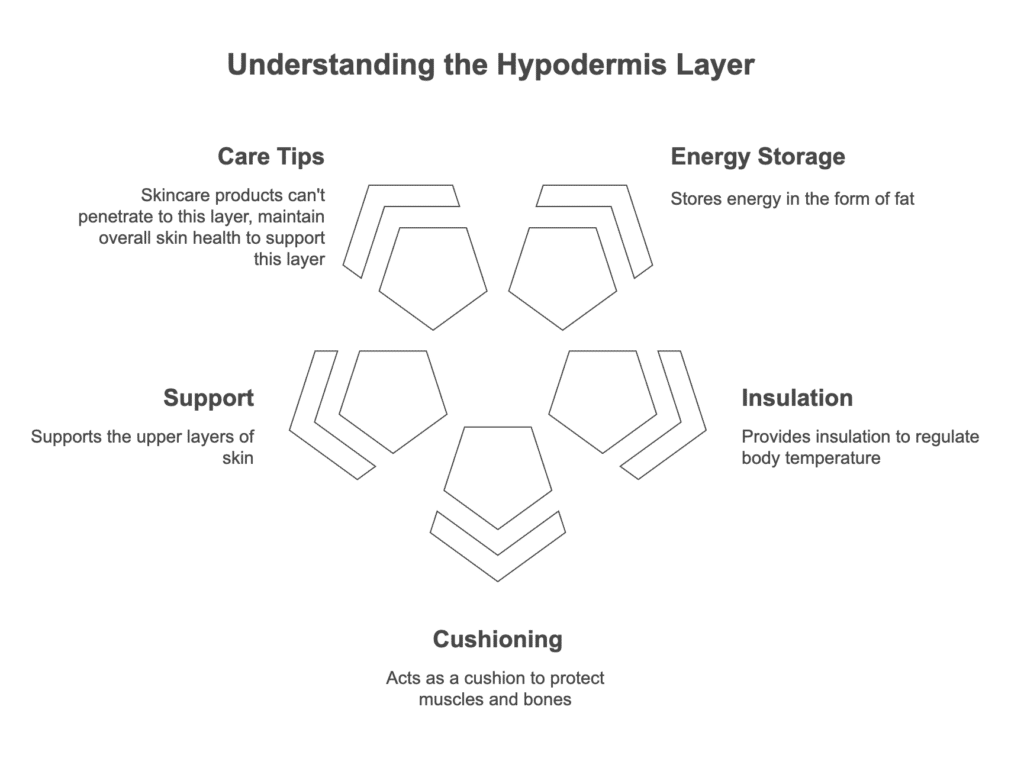
How Do the Skin Layers Work Together?
Each layer of your skin plays a unique role, but they work as a team to keep your skin healthy and functional. For example:
- The epidermis acts as a shield, but it relies on the dermis for hydration and nutrients.
- The dermis produces collagen and elastin, but it needs the hypodermis for structural support.
When one layer is compromised, it can affect the others. That’s why a holistic approach to skincare is essential.
Common Skin Problems and the Layers They Affect
Understanding which layer of skin is affected by a specific issue can help you choose the right treatments:
- Acne: Starts in the dermis (oil glands) but shows up on the epidermis.
- Wrinkles: Caused by collagen breakdown in the dermis.
- Hyperpigmentation: Affects the melanocytes in the epidermis.
- Dryness: Results from a damaged stratum corneum in the epidermis.
Expert Tips for Maintaining Healthy Skin at Every Layer
Here’s how to care for your skin holistically:
- Protect Your Epidermis:
- Use sunscreen daily to prevent UV damage.
- Avoid harsh cleansers that strip your skin’s natural oils.
- Incorporate products with ceramides and niacinamide to strengthen the skin barrier.
- Nourish Your Dermis:
- Use retinoids to boost collagen production.
- Apply serums with hyaluronic acid for hydration.
- Eat a diet rich in antioxidants to fight free radicals.
- Support Your Hypodermis:
- Maintain a healthy weight to avoid rapid fat loss.
- Stay active to promote good circulation.
- Adopt the CLEAR Skin Framework (Moving Beyond Product-First Thinking): Jumping straight to products without understanding their skin’s needs is one of the biggest mistakes people make. The CLEAR Skin Framework helps to break this cycle by first understanding their skin’s structure and function.
- Classify Your Skin Type: Know whether your skin is oily, dry, combination, or sensitive.
- Learn Your Skin Needs: Identify your primary concerns, like acne or ageing.
- Establish SMART Goals: Set specific, measurable, achievable, relevant, and time-bound goals for your skin.
- Assemble a Personalised Routine: Choose products that target your unique needs.
- Review & Track Progress: Regularly assess your skin’s condition and adjust your routine as needed.
How Much Can Skincare Really Help?
While skincare can’t change the structure of your skin, it can significantly improve its appearance and health. Consistent use of the right products can:
- Strengthen the skin barrier.
- Boost collagen production.
- Protect against environmental damage.
However, skincare works best when combined with a healthy lifestyle, including a balanced diet, adequate sleep, and stress management.
Build Healthy Skin from the Inside Out
Understanding your skin’s layers is the foundation of effective skincare. By knowing how each layer works and what it needs, you can make informed decisions and build a routine that truly supports your skin’s health.
Remember, healthy skin isn’t about perfection—it’s about consistency, care, and patience.
What are the three layers of skin, and what do they do?
The three layers of skin are:
Epidermis: The outermost layer that acts as a protective barrier and prevents water loss.
Dermis: The middle layer that provides strength and elasticity through collagen and elastin, and houses sweat glands, oil glands, and blood vessels.
Hypodermis: The innermost layer made of fat and connective tissue, which cushions and insulates the body.
Each layer works together to keep your skin healthy and functional.
Why is it important to understand the layers of skin?
Understanding the layers of skin helps you choose the right skincare products and treatments for your specific concerns. For example, knowing that wrinkles form in the dermis can guide you to use collagen-boosting ingredients like retinoids. It also helps you appreciate how skincare works to protect and nourish your skin at every level.
Which layer of skin is affected by acne?
Acne primarily starts in the dermis, where sebaceous (oil) glands overproduce oil, leading to clogged pores. However, the effects of acne, such as redness and inflammation, are visible on the epidermis. Treating acne requires addressing both layers with products like salicylic acid (to unclog pores) and niacinamide (to reduce inflammation).
Can skincare products penetrate all layers of the skin?
Most skincare products work on the epidermis, the outermost layer. Some ingredients, like retinoids and peptides, can penetrate into the dermis to stimulate collagen production. However, skincare products cannot reach the hypodermis, as it is too deep. Maintaining overall skin health through a consistent routine and a healthy lifestyle is key to supporting all layers.
How can I protect the epidermis, the outer layer of skin?
To protect the epidermis:
Use a gentle cleanser to avoid stripping natural oils.
Apply a broad-spectrum sunscreen daily to shield against UV damage.
Moisturise with products containing ceramides to strengthen the skin barrier.
Exfoliate 1-2 times a week to remove dead skin cells, but avoid over-exfoliating.
These steps help maintain a healthy, hydrated, and resilient outer layer.
How does the CLEAR Skin Framework help improve skin health?
The CLEAR Skin Framework is a 5-step system designed to help you build a personalised skincare routine:
C: Classify Your Skin Type to understand its unique needs.
L: Learn Your Skin Needs by identifying your primary concerns, like acne or ageing.
E: Establish SMART Goals to set realistic and measurable skin goals.
A: Assemble a Personalised Skincare Routine with products tailored to your needs.
R: Review & Track Progress to adjust your routine as your skin evolves.
By following this framework, you can address your skin concerns effectively and achieve long-term results.






